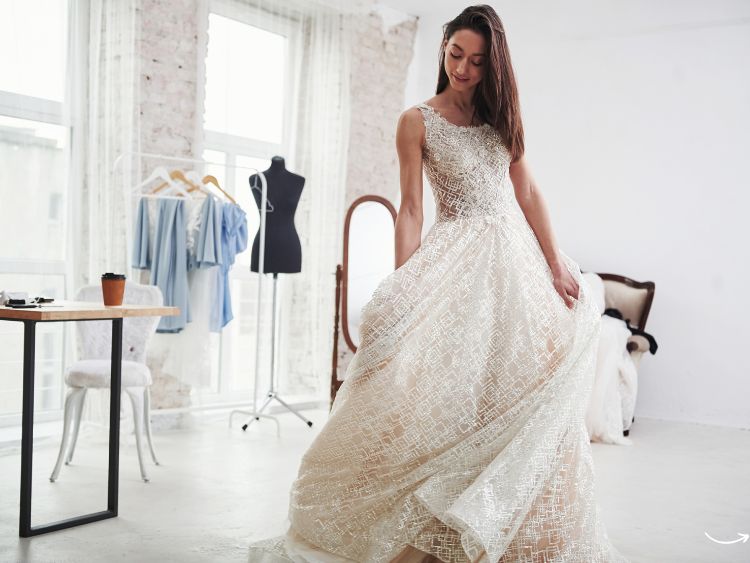Congratulations! You’re engaged and ready to embark on the exciting journey of finding the perfect wedding dress. One crucial aspect of this journey is the wedding dress fitting. Understanding wedding dress fitting etiquette can make this experience enjoyable and stress-free. From the first appointment to the final fitting, knowing what to expect and how to prepare will ensure you look and feel your best on your big day.
What to Expect at Your First Wedding Dress Fitting
Your first wedding dress fitting is a significant milestone. It’s when you’ll see how the dress looks on you and how it fits your body. Here are some essential tips to help you prepare:
Schedule Your Appointment in Advance
- Timing is everything: Schedule your first fitting about three months before your wedding day. This gives ample time for any necessary alterations.
- Choose wisely: Select a time when you’re not rushed. You’ll want to have plenty of time to try on the dress, discuss alterations, and make any necessary decisions.
Bring the Right Undergarments and Shoes
- Undergarments: Wear the undergarments you plan to wear on your wedding day. This includes any shapewear or special bras.
- Shoes: Bring the shoes you intend to wear with your dress. The heel height will affect the dress length and fit.
Communicate with Your Seamstress
- Be clear: Clearly communicate your vision and any concerns you have with your seamstress. This ensures that both you and the seamstress are on the same page.
- Listen to advice: Your seamstress has experience and can provide valuable insights on what will work best for your dress and body type.
Key Etiquette for Wedding Dress Fittings
Limit Your Entourage
- Keep it small: Bring only one or two trusted people whose opinions you value. Too many opinions can be overwhelming and confusing.
- Choose wisely: Select individuals who will be supportive and honest. Avoid bringing people who may cause stress or negativity.
Be Punctual
- Respect the schedule: Arrive on time for your fittings. This shows respect for the seamstress’s time and ensures you have the full allotted time for your fitting.
- Be prepared: Have everything you need ready before your appointment to avoid any last-minute rush.
Stay Open-Minded
- Be flexible: Be open to suggestions from your seamstress. They might suggest alterations that you hadn’t considered but will enhance the fit and look of your dress.
- Stay positive: Remember that alterations are a normal part of the process. It’s rare for a dress to fit perfectly right off the rack.
The Fitting Process: Step-by-Step
First Fitting
- Initial Try-On: You’ll try on your dress to see how it fits and to identify any areas that need alteration.
- Discussion: Discuss with your seamstress what changes are needed. This could include adjusting the hem, taking in the bodice, or adding details.
- Pinning and Marking: The seamstress will pin and mark the areas that need alteration.
Second Fitting
- Check Adjustments: Try on the dress again to check the initial adjustments.
- Fine-Tuning: Additional alterations may be needed based on how the dress fits after the first round of adjustments.
- Assess Comfort: Ensure the dress is comfortable and allows for easy movement.
Final Fitting
- Final Touches: The seamstress will make any last-minute adjustments to ensure the perfect fit.
- Full Ensemble: Bring all accessories, including veil, jewelry, and shoes, to see the complete look.
- Walk and Move: Practice walking, sitting, and dancing in your dress to ensure it’s comfortable and stays in place.
Common Wedding Dress Alterations
Hemming
- Adjust Length: Hemming ensures your dress is the perfect length, whether you have a long train or a simple hemline.
- Bustle: Adding a bustle allows you to lift the train for easier movement during the reception.
Taking In/Letting Out
- Adjust Fit: The dress may need to be taken in or let out at the bust, waist, or hips for a perfect fit.
Adding/Removing Details
- Customization: You can add or remove straps, sleeves, or embellishments to personalize your dress.
Wedding Dress Fitting FAQs
How Many Fittings Will I Need?
Typically, you’ll need three fittings: the initial fitting, a follow-up, and a final fitting. However, this can vary depending on the complexity of the alterations.
What Should I Bring to My Fittings?
Bring the undergarments, shoes, and accessories you plan to wear on your wedding day. Also, bring any specific items your seamstress requests.
When Should I Schedule My Final Fitting?
Schedule your final fitting about two to three weeks before your wedding. This allows time for any last-minute adjustments.
What If I Lose or Gain Weight?
If you anticipate weight changes, discuss this with your seamstress early on. They can schedule fittings accordingly and advise on the best time for alterations.
Can I Make Changes After the Final Fitting?
While minor tweaks can be made after the final fitting, significant changes should be avoided. Ensure you’re happy with the fit and look during the final fitting.
Conclusion
Wedding dress fittings are an essential part of preparing for your big day. By following proper wedding dress fitting etiquette, you’ll ensure a smooth and enjoyable process. Remember to schedule your appointments in advance, bring the right accessories, limit your entourage, and communicate clearly with your seamstress. With these tips in mind, you’ll be well on your way to looking and feeling your best on your wedding day.
Authoritative Links
- www.brides.com/wedding-dress-fittings
- www.theknot.com/content/wedding-dress-alterations
- www.weddingwire.com/wedding-dress-fitting-tips
- www.marthastewartweddings.com/wedding-dress-alterations
- www.bridalguide.com/fashion/wedding-dresses/wedding-dress-fitting-tips
By adhering to these guidelines and etiquette, you’ll ensure that your wedding dress fitting process is as seamless and enjoyable as possible. Enjoy this special journey and get ready to shine on your wedding day!

